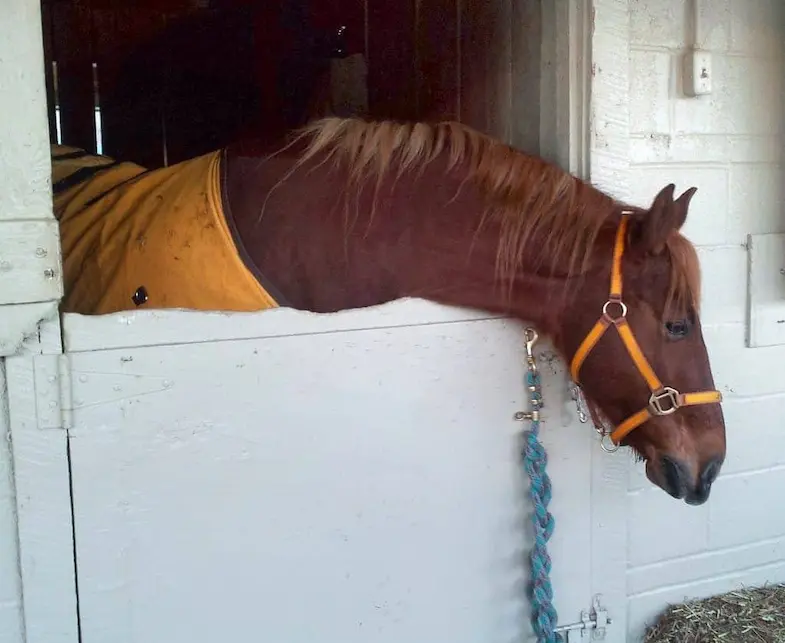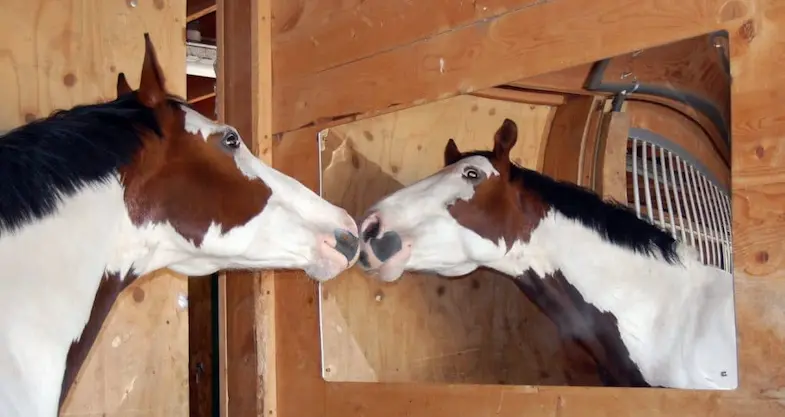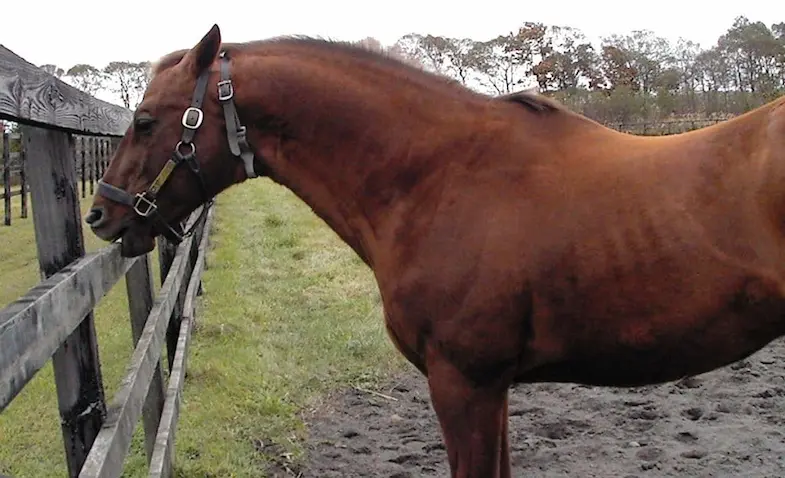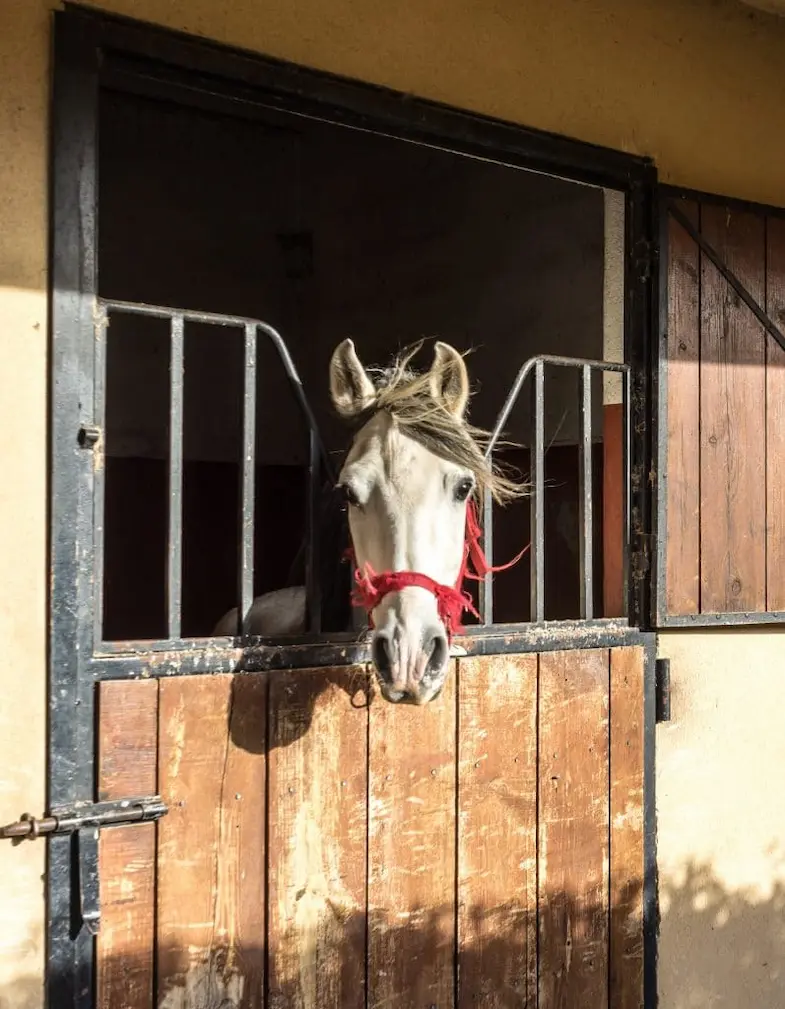There’s a number of different reasons why your horse may be weaving but it’s important to remember that weaving is considered a vice which means it’s a bad habit for your horse to have. Luckily though it’s a habit that you can easily help not only prevent but also stop all together.
What causes my horse to weaver?
Weaving is generally a learned habit that’s usually brought about by stress and or boredom. Horses are herd animals and don’t like to be isolated from other horses. They feel safer and better protected from predators in a herd so taking them away from the herd, for whatever reason, will undoubtedly cause them stress.
Some cases of weaving are caused by anticipation rather than by stress. This is where a horse gets excited when they anticipate feeding for example and start to weave out of excitement. It’s not clear why they do this but it’s thought that it helps to get rid of the energy and tension the anticipation has caused.
The other cause of weaving is genetic where either the sire or dam (or even both) are weavers. In most cases, the horse doesn’t necessarily start weaving from birth but are more likely to start if, for example, they see another horse.
What does weaving mean?
The most common form of weaving is where the horse continuously moves his weight from one foreleg to the other as he also moves his head and neck from side to side. Some horses will sway their whole body and even pick up their front legs as they do this. While the act of weaving itself doesn’t usually create any problems, over a long period of time it can create abnormal hoof wear and stress the horse’s joints which can increase the possibility of lameness. Some studies have linked long term weaving to weight loss and uneven muscle development. It’s worth noting though that this is if your horse has a long period of weaving, not if it only lasts for a short period of time.
How do I prevent my horse weaving?
To prevent weaving you first need to understand why your horse is doing it. There’s no point trying to prevent stress weaving if your horse is actually weaving due to excitement.
Stress/boredom weaving:
Weaving can start to develop with horses that have been stabled for a prolonged period of time. If your horse has an injury or a contagious illness and has to be stabled then you need to find things to help keep him stimulated. Weaving is as much a sign of bored as it is of stress as the two can often go together.
If your horse has to be stabled for a long period of time (anything over a few days) it’s important that you keep him occupied as much as possible. Remember that horses are social animals and don’t like being on their own. If your horse is stabled because of an injury consider stabling him in a field close to his friends, this will give him some company and therefore reduce his stress levels. If your horse is quarantined due to illness then this isn’t a good idea but you could stable him facing a busy area such as the food or tack room. The coming and going from these areas will help to keep his interest.
Stable toys can also really help to keep your horse occupied. Treat toys can be excellent for this as they encourage horses to ‘play’ with the toy to get treats. If you don’t have anything like this even a hanging salt lick can help because unlike fixed salt licks that stay in the same place all the time your horse will have to work harder to get anything from one that moves all the time.
Anticipation weaving:
To help prevent your horse from weaving out of anticipation try not to keep to a strict routine. Rather than feed your horse, muck out then turn him out why not feed him outside while you muck out. Then place him back in the stable before turning him out a little bit later. You don’t have to drastically change your routine just vary it slightly. This will help to prevent your horse learning your habits and thus weaving from anticipation.
Genetic predisposition weaving:
Prevent genetic predisposition weaving can be harder than preventing stress or anticipation weaving because it’s a behavior the horse instinctively understands. There’s no hard evidence to suggest it’s correct but there’s a lot of research indicating that horses who are predisposed to weaving can begin to do so from seeing others weave.
The best way to prevent a predisposed horse from weaving is to keep him stimulated and occupied but also try to keep him away from other ‘weavers’.
Using a mirror:
This may sound like a really obscure tip but it does actually work. If you’re able to place a plastic or metal mirror (or a glass mirror behind a protective shield) in the stable your horse will think it’s another horse which will help to prevent him from feeling isolated and ease his stress. Evidence has shown that horses don’t recognize themselves in a mirror so think it’s another horse, regardless of the fact they can’t smell the ‘other’ horse.
What’s the difference between weaving and stall walking?
Stall walking is a form of weaving where instead of standing on the spot and weaving from side to side the horse will walk up and down. Despite being referred to as stalling walking it’s not confined to a stable, horses at pasture can pace up and down along a fence. Like weaving though it can be caused out of stress, anticipation, or be inherited so the majority of the time it can be prevented (and stopped) in the same way.
Are there other vices I need to look out for?
Instead of weaving (or sometimes as well as), some horses will start cribbing (or wind sucking as it’s also known). This is where the horse bites the stable door or fence and then arches his neck. He will also contract his lower neck and retract the larynx, this causes the horse to ‘suck’ in the air which is where the term ‘windsucking’ comes from. It’s thought that the wind sucking is a result of biting or grasping rather than being a separate behavior.
Is weaving always considered to be a vice or can there other causes?
While a large number of horses that weave (or crib for that matter) do it as a habit it is always advisable to have your horse checked by the vet, especially if you’re not aware of an obvious cause. Both weaving and cribbing can also be a sign of your horse being in pain or unhappy about something. Evidence has shown that horses with ulcers may start cribbing as a direct result of the ulcer.
My horse is on his own, how do I stop him from getting bored.
Horse’s are herd animals but that doesn’t mean to say that you have to keep them with other horses. Yes of course it’s better if you can keep your horse with other horses but if not then there are a lot of other animals that offer great companionship for horses. Goats and sheep are good choices and even cats can be better than nothing.
Is it a good idea to install ‘V’ bars over the stable door?
Anti-weaving bars, sometimes call ‘V’ bars, should only be used to help stop a horse that is already weaving. The design of them means that the horse is unable to weave. The problem with anti-weaving bars though is that they can often make your horse feel even more confined and therefore increase his stress. This is why they should only be used to stop a horse that is already weaving.
Conclusion
Hopefully, you’ll never need to deal with a weaver but as you can see it’s not really a problem if you do. A few simple toys, a mirror, and some company is all you need in most cases. If you’re not sure what’s caused your horse to weave or you can’t prevent it it’s always advisable to have your horse checked over by a vet to make sure there’s no underlying issue or anything more serious.
I hope you found this article helpful. If you did I’d be grateful if you could share it please as it would really help me.
Recommended products
Over the years I have tried hundreds of different horsey products, from various blankets and halters to different treats. Some I’ve loved, others I’ve hated but I thought I’d share with you my top all-time favorite products, the ones I never leave the yard without. I’ve included links to the products (which are in no particular order) that I really think are great.
- Horse Knots by Reference Ready – If you’re like me and enjoy pocket reference guides then you’ll love this knot tying guide. These handy cards can easily fit in your pocket or attach to the saddle for quick reference. They’re waterproof, durable and are color coded to make them easy to follow.
- Mane ’n Tail Detangler – Even if you never show your horse you’ll need to detangle his tail from time to time (and possibly his mane too) which is always a challenging chore! I’ve found that if I run a little bit of detangler through my horse’s tails every few days it stops them from getting matted up and makes combing them easy, even if they’re coated in mud. I don’t know if I should admit to this or not but it also works wonders on my hair.
- TAKEKIT Pro clippers – Over the years I’ve tried a lot of different clippers and while some were obviously better than others I found these to be by far the best. They are heavier than a lot of other clippers but for me, that’s a good thing, it makes them feel more sturdy and hardwearing. On top of that they have a range of speeds so are just as good for clipping your horse’s back as they are his face. I also like the fact that they come in a handy carry case but that’s not for everybody. The company that makes them is super good and incredibly helpful too, a real bonus these days. The only thing I wasn’t keen on was the fact that it doesn’t come with any oil, but that’s not a major problem as it’s not difficult to buy lubricant.
- Shire’s ball feeder – There are so many boredom buster toys out there but I like to use these every day, regardless of whether or not my horses are bored. I find that it helps to encourage my horses to problem solve by rewarding them with treats (or pieces of fruit) but it also mimics their natural grazing behavior which helps to keep them calm and de-stressed.
- Horse safe mirror – This is a strange one that many people are surprised about but I like to put horse safe mirrors in the trailers as well as in the quarantine stalls. It helps to prevent the feeling of isolation by giving the impression of other horses being around. Being herd animals horses can get extremely stressed when they feel that they’re on their own but with these stick-on mirrors, they believe that at least one other horse is with them.
- Rectal thermometer – I know this isn’t glamourous at all but it’s vital for your horse’s well-being to be able to check their temperature and a rectal thermometer is the easiest way of doing this which is why I’ve added it to the list.
Shopping lists
I’ve also put together a few shopping lists of essential items that I’ve found helpful over the years. I’ve broken the lists down into different categories rather than put everything in one massive list 😉




